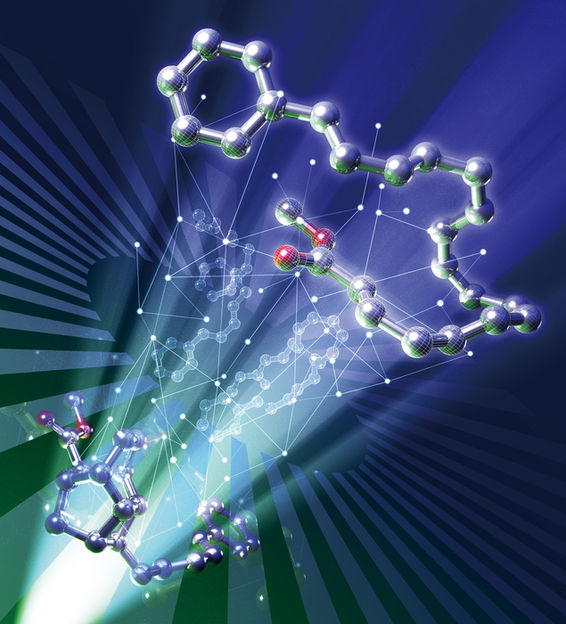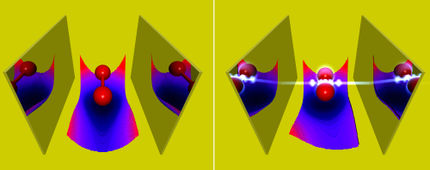Automated chemical reaction prediction: Now in stereo
Automated reaction path search method predicts accurate stereochemistry of pericyclic reactions using only target molecule structure
Researchers at the Institute for Chemical Reaction Design and Discovery (WPI-ICReDD) have demonstrated the expanded use of a computational method called the Artificial Force Induced Reaction (AFIR) method, predicting pericyclic reactions with accurate stereoselectivity based only on information about the target product molecule. The accurate prediction of a molecule’s stereochemistry—i.e., the 3D arrangement of its constituent atoms—is unprecedented for such an automated reaction path search method. This study serves as proof of concept that the AFIR method has the potential to discover novel reactions with specific stereochemistry.

The AFIR method traces back the reaction of endiandric acid C methyl ester, a 52-atom natural product, to its starting materials using only quantum chemical calculations.
Tsuyoshi Mita et al. Journal of the American Chemical Society. November 30, 2022
In this study, AFIR is used to calculate retrosynthetic, or reverse, reactions going from product molecules to starting materials. Previously, AFIR has been used to predict small, simple reactions, but accurate stereochemistry predictions were out of reach, limiting the technique’s applicability. In this study, researchers overcome this hurdle by using the AFIR method on a major class of chemical reactions called pericyclic reactions, which are commonly found in biological processes, including the synthesis of Vitamin D.
A key property of pericyclic reactions is that they have the same stereochemical relationship whether the reaction is happening in the forward or backward direction. This enabled the team to use the stereochemistry computed for the backward reaction to accurately predict the stereochemistry for the forward reaction. Notably, AFIR was also able to correctly predict stereochemistry for a reaction that breaks the Woodward-Hoffman rules, which typically govern the behavior of pericyclic reactions. The capability of this technique to predict exceptions to these standard rules demonstrates the potential for using this automated method to discover unintuitive reactions that may otherwise be overlooked.
Pericyclic reactions are also advantageous for computational work because they are concerted, which means all the bond-breaking and bond-making happens in a single step. Since such reactions do not go through ionic intermediates, it is tough for solvent molecules to alter the reaction and allows researchers to ignore solvent effects in their computations. Such computations are simpler to perform and thus enable more complex molecules to be handled. In this study, AFIR successfully handled molecules of up to 52 atoms, over 2.5 times the size of molecules in previous studies.
Importantly, the only information needed to use AFIR is the structure of the desired product molecule, so researchers can input a molecule they want to make and effectively hit the rewind button to find promising starting materials. Expanding the use of AFIR to encompass larger molecules and stereospecific processes opens up new avenues for automated reaction discovery.
Lead author Tsuyoshi Mita was also struck by the significance of using an automated approach to recreate historically significant reactions.
“The Woodward-Hoffmann Rules were established in the 1960s and I think it is very profound that 60 years later we are able to use automated reaction path searching methods to predict a reaction’s starting materials with stereochemistry that follows these rules,” said lead author Tsuyoshi Mita. “Endiandric Acid C was synthesized by Nicolau in 1982 based on Black’s biosynthetic hypothesis, and I am very pleased that in this work we were able to recreate what was in their heads using quantum chemical computations. I am both an organic synthetic chemist and a user of the AFIR method and in this project I was once again reminded of the power of the AFIR method.”
Original publication
Other news from the department science

Get the chemical industry in your inbox
By submitting this form you agree that LUMITOS AG will send you the newsletter(s) selected above by email. Your data will not be passed on to third parties. Your data will be stored and processed in accordance with our data protection regulations. LUMITOS may contact you by email for the purpose of advertising or market and opinion surveys. You can revoke your consent at any time without giving reasons to LUMITOS AG, Ernst-Augustin-Str. 2, 12489 Berlin, Germany or by e-mail at revoke@lumitos.com with effect for the future. In addition, each email contains a link to unsubscribe from the corresponding newsletter.
Most read news
More news from our other portals
Last viewed contents
WACKER expands production capacity for dispersions at its Burghausen site - Annual capacity to increase by 60,000 metric tons
Dürr and DLR cooperate in micro gas turbine technology

How solvent molecules cooperate in reactions
Mica
Bayer MaterialScience inaugurates Color Competence and Design Center in India

Simulating nature’s cosmic laboratory, one helium droplet at a time


























































